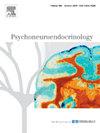黄体期舍曲林治疗经前性欲障碍(PMDD):对下丘脑-垂体-肾上腺(HPA)轴激活和炎症标志物的影响
摘要
理论依据月经前期情感障碍(PMDD)的特点是在月经周期的黄体期出现严重的情感症状。有证据表明,在 PMDD 中,下丘脑垂体性腺轴(HPG)和下丘脑垂体肾上腺轴(HPA)之间的相互作用发生了改变。本探索性研究的目的是确定:1)PMDD 患者和对照组在整个月经周期中 HPA-HPG 轴的相互作用和免疫标记物是否存在差异;2)黄体期舍曲林治疗对应激和炎症标记物有何影响。方法参与者为年龄在18-50岁之间、月经周期规律、未使用精神药物或激素药物的女性,根据前瞻性每日症状评分和临床访谈将其分配到对照组或PMDD组。在卵泡期和黄体期,在涉及轻度压力任务的实验室课程中抽取血液。在第二个黄体期,PMDD 参与者从排卵到月经期间接受开放标签舍曲林(50 毫克/天)治疗。血清皮质醇和促肾上腺皮质激素通过酶联免疫吸附测定法(ELISA)进行测定,并以相对于地面的曲线下面积(AUCg)和完成实验室任务后的峰值水平来表示。血清 TNF-α、IL-6、CXCL-8 和 IL-1β 采用多重试剂盒进行测定。血清异丙孕酮(ALLO)通过气相色谱/质谱进行测定。为了描述PMDD参与者和对照组在整个月经周期中HPA-HPG轴的相互作用,多层次线性模型通过周期阶段(控制舍曲林治疗)、ALLO和组别的相互作用来预测皮质醇和促肾上腺皮质激素。为了确定舍曲林治疗对炎症标志物的影响以及各组在每种标志物的周期性变化上可能存在的差异,多层次线性模型根据周期阶段(控制舍曲林治疗)和组别预测了炎症标志物。最后一组探索性模型测试了炎症标志物是否能预测经前症状评分的严重程度。结果样本包括77名参与者(41名对照组,36名PMDD组);28名患有PMDD的参与者完成了舍曲林治疗。组x阶段x ALLO的交互作用表明,较高的ALLO水平可预测治疗后黄体期较低的皮质醇峰值(阶段与ALLO之间的交互作用,p=0.042),治疗后黄体期的皮质醇峰值高于未治疗的黄体期(p=0.038)。在控制了组别和周期阶段后,CXCL-8 与经前期症状严重程度有明显相关性(p=0.011)。组别、生理期或 ALLO 对皮质醇 AUCg、促肾上腺皮质激素 AUCg、IL-6、CXCL-8、IL-1β 和 TNF-α 均无主效应(p's>0.05)。然而,在黄体期进行舍曲林治疗与较高的ALLO水平有关,这预示着对轻度实验室应激反应的皮质醇峰值较低,这表明舍曲林治疗可使PMDD患者的HPG-HPA轴相互作用正常化。更严重的经前症状与更高水平的炎症标志物CXCL-8有关,但还需要进一步研究炎症在PMDD中的潜在作用。Rationale
Premenstrual dysphoric disorder (PMDD) is characterized by severe affective symptoms during the luteal phase of the menstrual cycle. There is some evidence of altered interactions between the hypothalamic pituitary gonadal (HPG) and hypothalamic pituitary adrenal (HPA) axes in PMDD. There is also evidence that similar affective disorders such as major depression and perinatal depression are associated with dysregulation in immune factors, but this has not been characterized in PMDD.
Aims
The goals of this exploratory study were to identify 1) whether HPA-HPG axis interactions and immune markers differ between PMDD patients and controls across the menstrual cycle; 2) how luteal phase sertraline treatment impacts stress and inflammatory markers.
Methods
Participants were females age 18–50 with regular menstrual cycles, not using psychotropic or hormonal medications, and were assigned to a control group or PMDD group based on prospective daily symptom ratings and clinical interview. Blood was drawn in the follicular and luteal phases, during laboratory sessions involving a mildly stressful task. In a second luteal phase, PMDD participants received open-label sertraline (50 mg/d) from ovulation to menses. Serum cortisol and ACTH were measured via ELISA and operationalized as area under the curve with respect to ground (AUCg), and peak level following laboratory task. Serum TNF-α, IL-6, CXCL-8, and IL-1β were measured using multiplex kits. Serum allopregnanolone (ALLO) was measured by gas chromatography/mass spectroscopy. To characterize HPA-HPG axis interactions across the menstrual cycle in PMDD participants and controls, multilevel linear models predicted cortisol and ACTH from the interaction of cycle phase (controlling for sertraline treatment), ALLO, and group. To determine the effects of sertraline treatment on inflammatory markers and how groups might differ in cyclical change on each marker, multilevel linear models predicted inflammatory markers from cycle phase (controlling for sertraline treatment) and group. A final set of exploratory models tested whether inflammatory markers predict premenstrual symptom score severity.
Results
The sample included n=77 participants (41 controls, 36 PMDD); 28 participants with PMDD completed sertraline treatment. Group x phase x ALLO interactions showed that higher ALLO levels predicted lower cortisol peak in the treated luteal phase (interaction between phase and ALLO, p=0.042), and there was a higher cortisol peak in the treated luteal phase than the untreated luteal phase (p=0.038). CXCL-8 was significantly associated with premenstrual symptom severity after controlling for group and cycle phase (p=0.011). There were no main effects of group, phase, or ALLO on cortisol AUCg, ACTH AUCg, IL-6, CXCL-8, IL-1β, nor TNF-α (p’s>0.05).
Conclusion
Serum markers of HPA axis and immune function did not vary by menstrual cycle phase nor PMDD status. However, sertraline treatment in the luteal phase was associated with higher ALLO levels predicting lower cortisol peak in response to mild laboratory stress, suggesting that sertraline treatment may normalize HPG-HPA axis interactions among individuals with PMDD. Greater premenstrual symptomatology was associated with higher levels of the inflammatory marker CXCL-8, but further research is needed into the potential role of inflammation in PMDD.

 求助内容:
求助内容: 应助结果提醒方式:
应助结果提醒方式:


